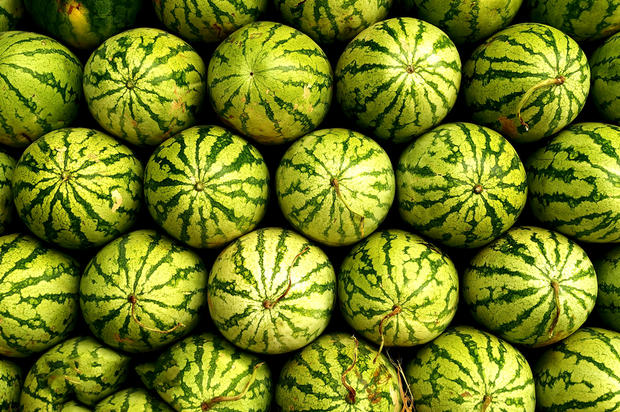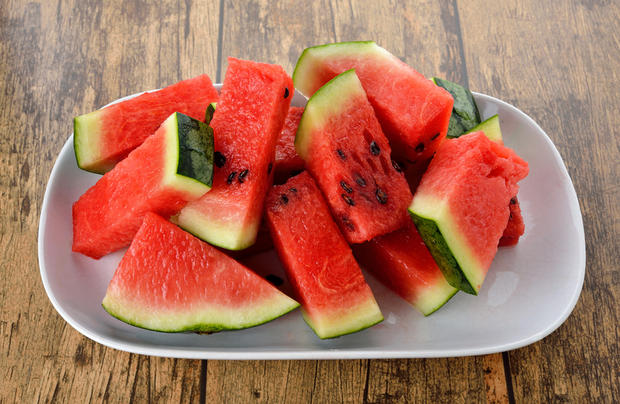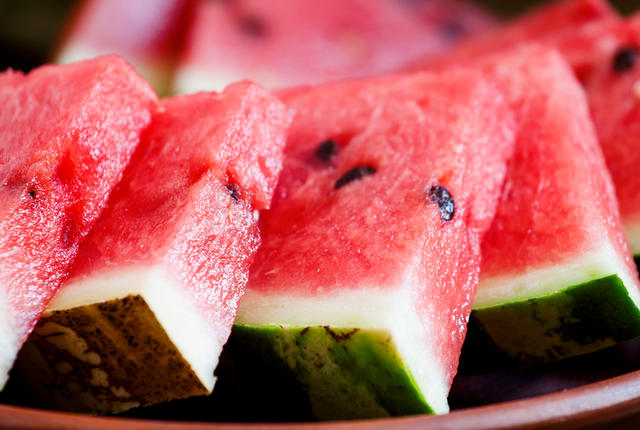10 Refreshing Facts About Watermelon

10 Refreshing Facts About Watermelon

sliced watermelon on plate with wood table background
August 3 is National Watermelon Day, and throughout summer, the backyard mainstay is added to drinks and served as dessert at barbecues across the country. Here are some tasty facts about this colorful, summertime treat.
1. WATERMELONS ARE BOTH FRUIT AND VEGETABLE.
Thanks to their sweet taste, watermelons are most commonly considered a fruit. And they do grow like fruit, originating from flowers that have been pollinated by bees, and, from a botanical perspective, they're fruits because they contain seeds. But many gardeners think of them as vegetables, since they grow them in their gardens alongside other summer veggies like peas and corn. Not to mention, watermelon is classified as part of a botanical family of gourds that includes other culinary vegetables like cucumber, squash, and pumpkin.
2. YOU CAN EAT THE ENTIRE FRUIT.
While we tend to focus on the melon’s succulent flesh, watermelon rinds are also edible—as well as full of nutrients with surprising health benefits. In China, the rinds are often stir-fried or stewed, while in the South, cooks like to pickle them. And, across the Middle East and China, the seeds are dried and roasted (similar to pumpkin seeds) to make for a light, easy snack.
3. THEY’RE CALLED WATERMELONS FOR A REASON.
They’re 92 percent water, making them a perfect refresher for those hot summer months.
4. THEY COME IN 1200 DIFFERENT VARIETIES.
To make classification a little easier, however, watermelons tend to be grouped into four main categories: seeded (or picnic), seedless, icebox (also known as mini, or personal size) and yellow/orange. One of the most popular varieties is the Crimson Sweet, a seeded melon with deep red, sweet flesh. Some of the more unusual varieties include the Golden Midget, whose rind turns yellow when its ripe, and the Cream of Saskatchewan, whose flesh is cream-colored.
5. THE SEEDLESS ONES ARE NOT GENETICALLY ENGINEERED.
Contrary to what you might have heard, seedless watermelons are the result of hybridization, a perfectly natural phenomenon that farmers can nevertheless capitalize on. A couple of decades ago, seedless watermelons were hard to find, but today they make up around 85 percent of those sold in the U.S. And those white “seeds” that you still find in your seedless slices? They’re actually empty seed coats and are perfectly safe to eat.

Watermelon slices on a clay plate, selective focus
6. WATERMELONS CAN GROW TO BE REALLY, REALLY BIG.
The heaviest watermelon to date was grown by Guinness World Record holder Chris Kent, of Sevierville, Tennessee, in 2013. A Carolina Cross, it weighed in at 350.5 pounds. To give you some perspective, that’s the equivalent of an NFL lineman.
7. WATERMELONS CAN HELP PREVENT CANCER.
Watermelons are a great source of lycopene, an antioxidant that’s been shown to reduce the risk of several types of cancers, including prostate, lung, and stomach.
8. JAPANESE FARMERS HAVE PERFECTED THE ART OF GROWING THEM IN ODD SHAPES.
Japanese farmers have been growing cube-shaped watermelons for the past 40 years, forcing them into their square shape by cultivating them in box-like braces. When the watermelon fills the cube and gets picked, it's generally not ripe yet, meaning the inedible melons are sold—for prices upwards of $100—as novelty items and gifts. (The original idea was for them to better fit into standard refrigerators.) More recently, farmers have grown watermelon in the shape of hearts—these particular melons taste as sweet as they look—as well as pyramids and human faces.
9. ONE SOUTH CAROLINA FAMILY KEPT AN HEIRLOOM VARIETY ALIVE FOR ALMOST 100 YEARS.
The unusually sweet Bradford—created by Nathaniel Napoleon Bradford in Sumter County, South Carolina, in the 1840s—was one of the most sought-after varieties the Deep South has ever seen. But its soft skin made it hard to transport, and by the early 1920s it had proved to be commercially unviable. It would have disappeared completely had the Bradford family not kept it alive in their backyard gardens for multiple generations. It’s now being grown commercially again by Nat Bradford, Nathaniel’s great-great-great grandson.
10. THEY’RE THE OFFICIAL STATE VEGETABLE OF OKLAHOMA.
In 2007, the Oklahoma State Senate honored its then-14th biggest crop by voting 44–2 to make it the state vegetable. (Why not fruit? That distinction was already given to the strawberry.) Its celebrated status was threatened last year, however, when State Senator Nathan Dahm moved to repeal the bill based on the argument that watermelon is a fruit. Thankfully for Oklahoma’s Rush Springs, home to an annual watermelon festival and the original bill’s sponsor, then-State Representative Joe Dorman, Dahm’s bill died in committee.
Политика конфиденциальности | Правила пользования сайтом








